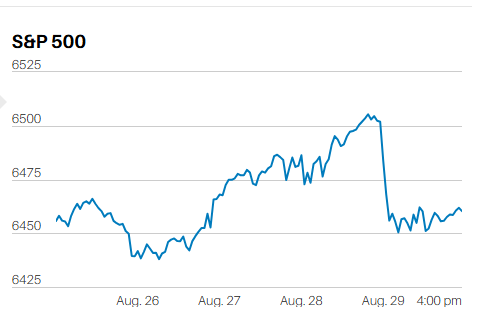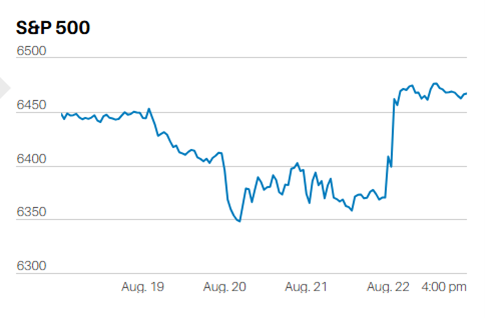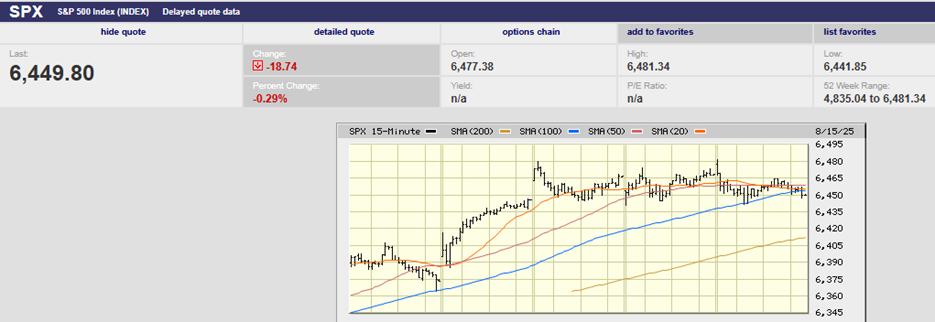Economic data weaker except the job market

Market Update
The S&P 500 lost 0.7% last week to finish at 3972.61. The index peaked Tuesday morning at 4015.39. The S&P tried to break above that number Wednesday morning but failed at 4014.16. Traders sold the index down to 3885.54 by noon Thursday. The S&P rallied back Friday to close near its high of 3972.96. The Thursday low of 3885 represents support. The 4015 area represents resistance.
We wrote last week that, “the next few days are critical to the S&P's near-term direction. A close above the resistance line in the coming week means a run to 4,100. Failure to break above over the next few trading days likely means a fall to 3,800.” The S&P closed right at the resistance line Tuesday. It has not been able to hold above it. Rather it failed to do so four trading days in a row. The index couldn’t hold the 200-day moving average last week either.
Four trading days have come and gone, and nothing has changed. The S&P needs to vanquish the downward trending resistance line soon. A sell-off to at least 3800 is likely otherwise. The Volatility Index (VIX) has fallen steadily since it peaked in early October. It hit 35 during the October market lows. The VIX closed below 20 last week. It fell below 20 in August of 2022 as well when the S&P peaked at 4,305. A low VIX coupled with disappointing earnings guidance could lead to a decline in the S&P.
There is increasing optimism among equity investors. Yet continued wage inflation will slow the decline in the CPI in the coming months. Caution is warranted. A pullback in the market is likely in the next month. How deep will depend on earnings and earnings guidance. It will also depend on how much progress is being made taming inflation.
Inflation may move higher not lower in the next few months. Easing financial conditions and a weaker dollar could cause inflation to stop falling. The assumption of linearity in future inflation data is unfounded. Translation: future inflation data isn’t necessarily going to continue to show improvement. Nor is it guaranteed to fall at a steady rate if it does continue to fall.
A weakening dollar impacts commodity and import prices. Commodity prices such as gasoline, oil, and copper are rising. Used auto prices are increasing also. The number of people eating out is increasing which will impact the cost of food away from home. All these measures are correlated to the CPI. Meanwhile, financial conditions are easing according to the Chicago Fed. Financial conditions are back to levels last seen in the spring of 2022. The Fed didn't start raising rates until March of 2022.
January inflation swaps are predicting higher not lower CPI. The January swaps are pricing the CPI to rise by 6.1% on a year-over-year basis, according to Mott Capital Management. That’s up from 5.9% at the beginning of January. The February swaps are rising even faster. They have climbed from 5.2% to 5.7% since the beginning of January. The CPI inflation swaps give us real-time estimates of future inflation. Those rising estimates are alarming. We can expect a negative reaction in the capital markets if inflation stops falling.
Economic Indicators
The economic data last week was weak. The Federal Reserve is making progress slowing the economy by reducing demand. Demand falls when interest rates rise. The Empire State manufacturing index was much worse than expected in January. It fell to negative 32.9 from negative 11.2. New orders and shipments declined substantially, according to the New York Fed. Inventories rose, likely due to weaker-than-expected demand. The buildup was probably not intentional.
Retail sales were also weaker than expected in December. Retail sales dropped 1.1%. Retail sales ex motor vehicles also fell 1.1% against expectations of a 0.5% decline. As well, industrial production weakened in December.
The housing market continued to weaken with existing home sales of 4.02 million in December. Homes sales were 4.08 million the prior month. Building permits were 1.33 million in December falling from 1.35 million the prior month. Housing starts were 1.38 million versus 1.40 million in November. Building permits are a leading indicator.
Jobs are a lagging indicator which may explain why the job market is still strong. Initial jobless claims were only 190,000 the week ending 14 January. That was down from an already low 205,000. The unemployment rate is still at a forty year low 3.5%. There are more than 10 million vacant jobs with fewer than 6 million unemployed. We wrote last week about rising wage growth. “The Atlanta Fed’s Wage Growth Tracker shows wages up almost 8% in November for workers switching jobs. Wage increases were 5.5% for workers staying in the same job in November. Overall, wage growth was running at 6% year-over-year.”
The Fed isn’t likely to stop raising rates until they see a slowdown in the jobs market. It needs a weakening jobs market to rein in wage growth. It needs wage growth to slow if inflation is to fall below 3%.
Bonds Play a Role
Most investors focus on stocks most of the time. Bonds get very little attention. Yet bonds play a critical role in the world of finance. In fact, the bond market is bigger than the stock market. Bonds can deliver cash flows to investors with far more certainty than stocks. It is the certainty that makes them so useful. Retirees should dedicate a portion of their portfolios to bonds. It will make achieving spending goals in retirement more likely.
Stocks are equity. You buy a stock; you own part of that company. You’re entitled to your share of the profits if there are any. A company can pay stockholders a dividend. It can buy back shares, increasing the remaining stockholders' ownership stakes. It can pay down debt, which will increase the value of the company’s equity. Finally, it can retain earnings to grow the business.
Regardless, the company is in control of how and when it dispenses profits to shareholders. And the stock market decides on any given day what a company’s stock is worth. Neither characteristic is ideal for investors with short-term spending needs. They need cash flows to show up at the right time and in the right amount.
Bonds excel at providing cash flows at the right time. Bond cash flows can be calculated with precision. Let’s say I have a spending goal in five years. I’ll need $20,000 for a new roof. Not willing to take any credit risk I buy five-year Treasury bonds, yielding 3.591%. I can buy $17,000 worth of 5-year Treasuries and receive a bit more than $3,000 in interest payments. My 5-year bonds will mature in five years, and I’ll receive my $17,000 in principal back. The principal plus the $3,000 in interest payments gives me the money I need for my new roof. There is no risk of a shortfall.
Of course, we wouldn't want our coupon payments sitting in cash waiting to be spent. Instead, we'd want to invest those coupons in bonds that matured in time for our spending goal. We'd end up with more than the required $20,000 if we did reinvest our coupons. We might decide to reduce our initial investment in that case. Of course, that allows uncertainty to build since we can’t know where interest rates will be when it’s time to invest our coupons. Still, it is an option.
There are other considerations when investing in bonds, but you get the point. Bond cash flows are more certain than stock cash flows. Certainty is an attractive trait for a retiree who needs to ensure that spending goals are met on time and in full. Investors shouldn't forget about bonds when building their portfolios.
Regards,
Christopher R Norwood, CFA
Chief Market Strategist











